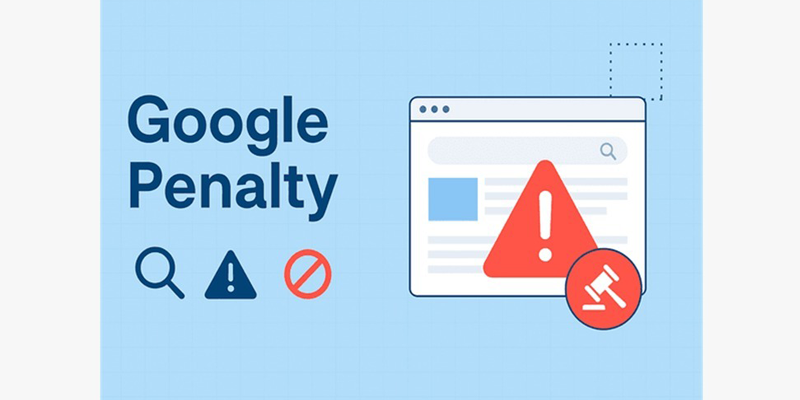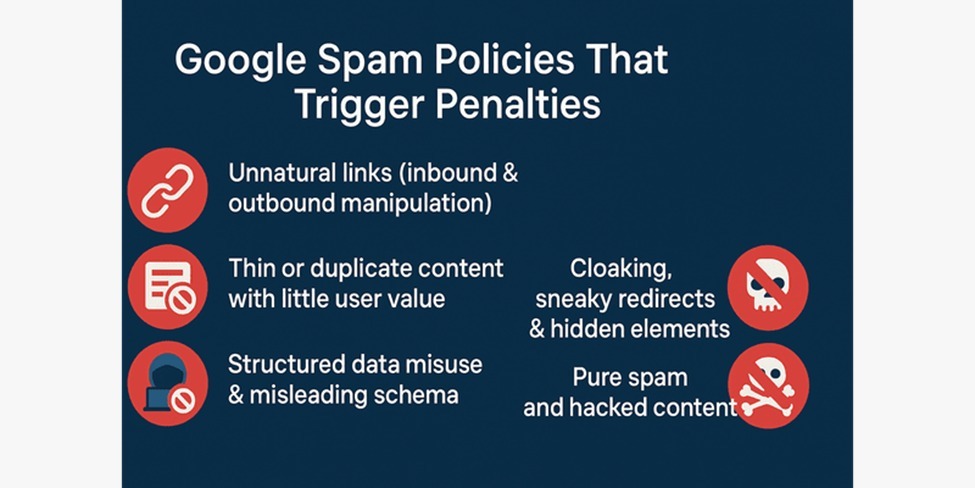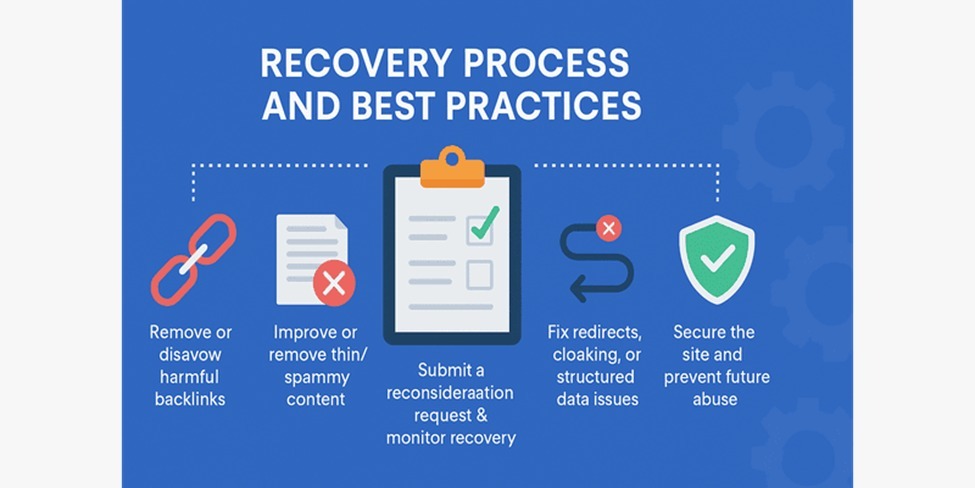

A Google penalty is not just a buzzword — it’s a critical red flag that your website has
violated Google’s search policies. When this happens, your site may experience a sudden drop
in rankings, visibility, and organic traffic. These penalties are designed to discourage
manipulative practices such as spammy link building, cloaking, or publishing thin, low-value
content.
Recovering from a penalty requires more than quick fixes. It involves identifyin Websites that demonstrate genuine value to users are not only more resilient to penalties but also rewarded in long-term search visibility.
Whether it’s a manual action triggered by a human reviewer or an algorithmic filter applied automatically, understanding the type of penalty is the first step in recovery.
Google can lower your site’s rankings in two primary ways:
Why this distinction matters:
Recognizing the difference helps you decide whether to fix issues and appeal to Google directly or focus on long-term SEO improvements.
Google applies penalties based on the severity and type of violation:
In both cases, recovery is possible but requires systematic cleanup. Google’s goal isn’t to permanently punish websites — it’s to ensure the best search experience for users. By fixing violations and improving site quality, you can not only recover but often return stronger than before.

Google’s search systems are designed to reward websites that provide relevant, trustworthy,
and high-quality content. To maintain this standard, Google enforces strict spam policies. When
sites violate these rules, either deliberately or unintentionally, they risk penalties that
reduce visibility in search results.
The most common triggers include manipulative link schemes, thin or duplicate content, cloaking and hidden elements, structured data misuse, and pure spam or hacked content. Each of these violations undermines user trust and search quality, which is why Google takes them seriously.
Links remain one of the strongest ranking signals, but manipulative link practices are a major cause of penalties. Examples include:
poThese tactics distort the natural web link graph and mislead Google’s algorithms. Penalties may come as manual actions in Search Console or algorithmic devaluation, where suspicious backlinks are ignored.
The corrective approach is to focus on earning links through original, authoritative content, removing harmful backlinks wheressible, and using the Disavow Tool only when necessary.
Google prioritizes content that demonstrates originality and user value. Thin or duplicate content signals low quality and may include:
Such content undermines user experience and is often flagged by Google’s algorithms. To address this, site owners should audit thin pages, consolidate duplicates, and expand c ontent with genuine insights that reflect expertise, experience, and authority.
Cloaking involves serving different content to search engines than to users. Similarly, sneaky redirects and hidden elements are viewed as attempts to deceive. Common examples are:
Such practices violate Google’s commitment to transparency between users and search engines. Regular technical audits, parity checks between mobile and desktop versions, and using Google’s URL Inspection tool can help identify and resolve these issues.
Structured data is a powerful tool to enhance visibility in search through rich results. Misuse, however, can lead to penalties. Examples include:
To stay compliant, structured data should always follow Google’s published guidelines. Validation with tools like the Rich Results Test and Schema.org validators ensures correct implementation.
Pure spam and hacked sites are among the most serious violations. These typically include:
These violations often result in complete de-indexing until the issues are resolved. Remediation requires either cleaning the hacked environment thoroughly or rebuilding a site’s content and trustworthiness from the ground up.
Detecting a penalty early is critical to recovery. Many website owners misinterpret traffic fluctuations as normal algorithmic changes or seasonal dips. However, penalties—whether manual or algorithmic—often leave clear traces. Monitoring performance trends, crawling status, and official notifications can help confirm whether your site has been penalized.
One of the strongest indicators of a penalty is a sharp, unexplained decline in traffic and keyword rankings. While gradual changes are common with search updates, penalties typically result in:
If your traffic decline aligns with a known Google update, the issue may be algorithmic. If the drop occurs outside of major updates, it could signal a manual action or severe spam policy violation.
Another sign is when pages disappear entirely from Google’s index. Running a simple “site:yourdomain.com” query can reveal whether your content is still being indexed. Warning signs include:
This typically happens when Google deems certain content to violate spam guidelines, or if the entire domain has been penalized. Regular indexing checks ensure problems are caught before they escalate.
When Google applies a manual action, it is communicated directly through Google Search Console. These notices provide:
Manual action notices are the most direct confirmation of a penalty. Unlike algorithmic issues, which must be inferred through traffic analysis, these notifications give site owners a clear starting point for recovery. Ignoring them can result in prolonged loss of visibility and authority
Once a penalty is suspected, identifying the exact trigger becomes the priority. Without proper diagnosis, recovery efforts risk being misdirected and ineffective. A thorough audit across backlinks, content, technical factors, and security helps isolate the root cause and guides the corrective steps.
Backlinks remain a common source of penalties. Conducting a detailed backlink audit helps detect whether your site is associated with unnatural or spammy link practices.
Key areas to evaluate include:
Tools such as Google Search Console’s Links report, Ahrefs, or SEMrush can help identify problematic backlinks. Removal requests, followed by selective use of the Disavow Tool, form the next step.
Thin, duplicate, or low-value content is another frequent cause of penalties. A content audit should assess:
Improving content means consolidating duplicates, adding depth to thin pages, and ensuring every piece delivers real user benefit. Applying E-E-A-T principles helps future-proof against algorithmic downgrades.
Technical issues can cause penalties or mimic their effects. Key areas to review include:
Running crawls with tools like Screaming Frog or Google’s URL Inspection tool can uncover errors quickly. Correcting these ensures Googlebot and users see the same, accurate content.
Security breaches can result in penalties, particularly when harmful or deceptive content is injected into a site. Common issues include:
Google flags hacked sites through Search Console under “Security Issues.” Prompt cleanup, applying patches, and implementing preventive measures such as firewalls and CAPTCHA systems are essential.

Recovering from a Google penalty is a systematic process that requires
addressing the specific violations identified during diagnosis. Success depends
on taking corrective action, documenting the changes, and demonstrating
to Google that the site now complies with its search policies.
Toxic backlinks are one of the most frequent penalty triggers. The recovery process begins with cleaning your link profile:
The key is to show Google that you have made a genuine effort to eliminate manipulative signals rather than relying solely on disavow. A healthier link profile sets the foundation for long-term recovery.
Content penalties require careful revision of existing pages. Steps include:
The goal is to demonstrate that the site provides unique, authoritative value beyond what competitors offer.
Technical violations need prompt resolution to restore trust:
Correcting these ensures that the site communicates transparently with both users and search engines.
Security-related penalties, such as those caused by hacked content or injected spam, require both cleanup and prevention:
Securing the site reassures both Google and users that it is safe and trustworthy.
For manual actions, recovery requires filing a reconsideration request in Google Search Console. A successful request should include:
Once submitted, Google reviews the case and notifies the site owner of its decision. Even after recovery, ongoing monitoring of rankings, traffic, and Search Console reports is essential. Recovery is often gradual, and demonstrating long-term compliance ensures stability.
Recovering from a Google penalty is only part of the journey. True resilience comes from preventing violations in the first place. By aligning with Google’s quality guidelines, maintaining a strong link profile, and staying vigilant, website owners can safeguard their visibility and authority in search results.
The foundation of penalty-proof SEO is content that delivers genuine value to users. Google increasingly prioritizes E-E-A-T — Experience, Expertise, Authoritativeness, and Trustworthiness — as guiding principles. To meet these standards:
Websites that consistently put user needs first are far less likely to be penalized and often benefit during algorithm updates.
Links remain critical for rankings but are also one of the easiest ways to attract penalties. Long-term success depends on building links responsibly:
A clean link profile strengthens credibility and minimizes the risk of manual or algorithmic penalties.
Regular site audits help catch potential issues before they escalate into penalties. Areas to include in routine checks:
Consistent monitoring through tools like Google Search Console, Analytics, and third-party SEO platforms ensures your site remains compliant with evolving standards.
Google’s search algorithms and spam policies evolve continuously. Staying informed helps anticipate risks and adapt proactively.
Proactive awareness prevents surprises and positions your site to benefit from updates instead of being harmed by them.
Understanding Google penalties in theory is important, but real-world examples provide deeper insight into how websites are impacted and what strategies work for recovery. Examining both successful recoveries and common mistakes helps site owners apply proven lessons to their own situations.
An online retailer experienced a steep decline in rankings after aggressively building backlinks through paid guest posts and link exchanges. Google issued a manual action for unnatural links. The recovery process involved auditing all backlinks, removing or disavowing over 2,000 toxic domains, and shifting focus toward digital PR campaigns and influencer collaborations. Within six months, the site regained most of its lost visibility and attracted higher-quality traffic.
A lifestyle blog network created multiple doorway pages with duplicated product reviews targeting different cities. Traffic dropped by nearly 70% during a spam update. The recovery included consolidating duplicate content, rewriting reviews with original insights, and adding author bios to demonstrate expertise. The stronger, user-focused content not only reversed the penalty but also improved engagement metrics.
A small service provider’s site was hacked, with injected pages promoting pharmaceutical products. Google flagged the domain for “pure spam” and deindexed many pages. The owner restored the site from backups, implemented stronger security protocols, and submitted a reconsideration request with evidence of cleanup. The site was reindexed within four weeks, demonstrating the importance of quick action against security breaches.
While recovery is possible, many sites prolong the process by taking the wrong approach. Common mistakes include:
Recovering from a Google penalty requires strategic effort, but prevention and maintenance are equally important. A structured checklist helps site owners maintain compliance, detect risks early, and protect visibility in search results.
Carrying out a monthly SEO and compliance audit ensures your website remains healthy and penalty-free. Focus areas include:
These audits not only reduce penalty risk but also improve user experience and site authority over time.
When a penalty occurs, acting systematically shortens recovery time. A proven roadmap includes
For businesses that lack the expertise or resources to manage this process effectively, partnering with an experienced SEO agency in Bangalore can accelerate recovery and provide long-term protection. Professional agencies bring specialized tools, proven frameworks, and industry knowledge to safeguard visibility and authority in competitive search landscapes.